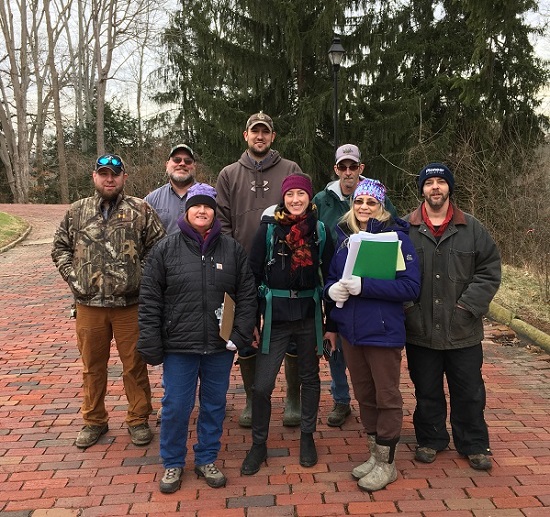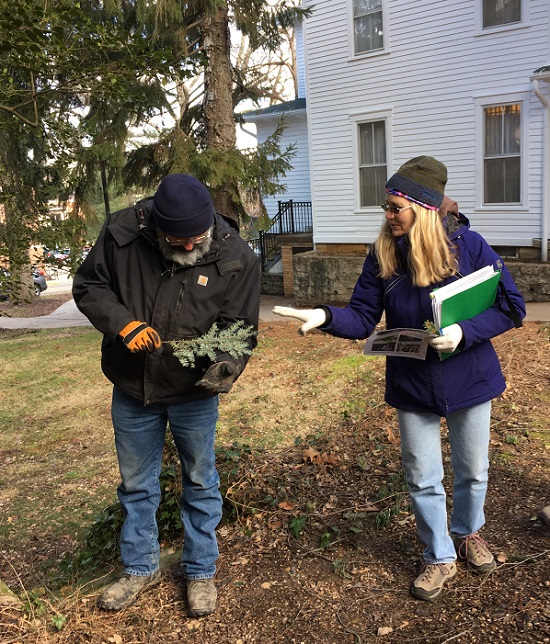Eastern hemlock trees are under attack in the United States by a tiny pest called the hemlock woolly adelgid.
The hemlock wooly adelgid is a tiny insect that feeds exclusively on hemlock trees. An invasive species first introduced from Japan, they threaten populations of hemlocks in Ohio and throughout the Eastern United States and Canada. Hemlock woolly adelgid was found in Athens County in 2017, but so far has not been found on the campus of Ohio University, according to Landscape Coordinator Susan Calhoun.
With the pest attacking trees in the surrounding counties, it won’t be long before it makes it to campus, says Calhoun. Tree Care Coordinator Meg Little, a graduate student in the Voinovich School’s Environmental Studies Program, and Calhoun have mapped the locations of some 90 hemlock trees in the managed areas on campus. This does not include hemlocks located in un-managed areas at the Ridges.
Evidence of woolly adelgid infestation is hard to spot unless you look very closely. The small insects are less than 1/16” long and are most easily spotted on the undersides on hemlock needles in the winter when they create a woolly white mass as a barrier against the cold temperatures.
Hemlocks are a vital part of the in the ecosystem, according to Little, since there are so many species, 96 bird species and 47 mammal species, that depend on the trees for food and habitat. “As one of a few native evergreen species, hemlock plays an important role in regulating temperatures on the forest floor and beside streams where they tend to grow,” Little said. “When all the deciduous trees drop their leaves, direct sunlight reaches the forest floor, but the hemlock continues to shade.”
Calhoun noted that this winter’s polar vortex was helpful in the fight against pests like the woolly adelgid since prolonged freezing temperatures can kill large segments of the population.
This winter Calhoun and Little hosted the first training session for members of the OHIO grounds staff on how to identify the woolly adelgid. “We are training Grounds Department staff to monitor on an annual basis for this pest,” said Calhoun, noting that they will respond with treatment as needed to protect the trees.
Several options exist for controlling the hemlock woolly adelgid once they have been found infesting trees. The trees and the soil around the trees can be treated with chemical insecticides. Calhoun noted that in areas near waterways, the treatment would involve tree injections, rather than soil treatment, to minimize the risk of water contamination. According to the Ohio Department of Natural Resources, several insect predators have also been identified for use in helping to control the woolly adelgid.
The threat of the woolly adelgid has not dissuaded Calhoun from planting more Hemlocks on campus. Hemlock saplings were among the native tree species planted in the last year as part of a unique project, funded by Housing and Residence Life, focused on the removal of invasive species and replanting of native trees and understory plants along the east-facing hillside below Bryan Hall between Shively Hall and Jefferson hill. Little noted that there were already many established hemlocks growing on that hillside which is a good spot for the native tree.
“Research shows that the last time hemlocks were wiped out, it took around 2,000 years for them to reestablish as a dominant species,” said Little. “They are slow-growers and would struggle to outcompete other species should they get wiped out in this area.”

undefinedGrounds staff stop for a photo during their Hemlock woolly adelgid identification training at The Ridges. From L-R front row: Latisha Price, Meg Little, and Susan Calhoun. Second Row: Dave Pennington, Dan Maccabee, Ryan Grim, Alan Trainer, and Mick Hornsby.

undefinedTommy Shaw and Susan Calhoun examine a hemlock branch outside Jennings House.
